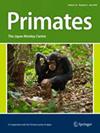蟒蛇对一只长胡子的卷尾猴的掠食性攻击。
IF 1.5
4区 生物学
Q2 ZOOLOGY
引用次数: 0
摘要
捕食影响觅食策略,因为灵长类动物在进食时必须避免被捕食。卷尾猴的某些种群是唯一一种习惯在地面上敲开坚果的新热带灵长类动物。这种耗时且需要集中注意力的觅食活动可能会增加对捕食事件的敏感性。然而,目前还没有使用工具的Sapajus种群的捕食数据。我们报告了在一个使用工具的种群中,一条蛇(蟒蛇)对一只胡须卷尾猴(S. libidinosus)的掠食性攻击,以及其他猴子的警报和威胁表现。我们证实了这些猴子的捕食脆弱性,并讨论了它们如何平衡觅食需求和捕食风险。本文章由计算机程序翻译,如有差异,请以英文原文为准。
Predatory attack on a bearded capuchin monkey by a Boa constrictor.
Predation influences foraging strategies, as primates must avoid being preyed on while feeding. Some populations of capuchin monkeys are the only neotropical primates that customarily use the ground for nut-cracking. This time-consuming and focus-demanding foraging activity may increase susceptibility to predation events. However, there is currently no data on predation in tool-using Sapajus populations. We report a snake's (Boa constrictor) predatory attack on a bearded capuchin monkey (S. libidinosus) in a tool-using population, as well as the other monkeys' alarm calling and threat displays. We confirm these monkeys' predation vulnerability and discuss how they balance foraging requirements with predation risk.
求助全文
通过发布文献求助,成功后即可免费获取论文全文。
去求助
来源期刊

Primates
生物-动物学
CiteScore
3.10
自引率
17.60%
发文量
71
审稿时长
>12 weeks
期刊介绍:
Primates is an international journal of primatology whose aim is to provide a forum for the elucidation of all aspects of primates. The oldest primatological journal, Primates publishes original papers that advance the scientific study of primates, and its scope embraces work in diverse fields covering biological bases of behavior, socio-ecology, learning and cognition, social processes, systematics, evolution, and medicine. Contributions relevant to conservation of natural populations and welfare of captive primates are welcome. Studies focusing on nonprimate species may be considered if their relevance to primatology is clear. Original Articles as well as Review Articles, News and Perspectives, and Book Reviews are included. All manuscripts received are initially screened for suitability by members of the Editorial Board, taking into account style and ethical issues, leading to a swift decision about whether to send the manuscript for external review.
 求助内容:
求助内容: 应助结果提醒方式:
应助结果提醒方式:


